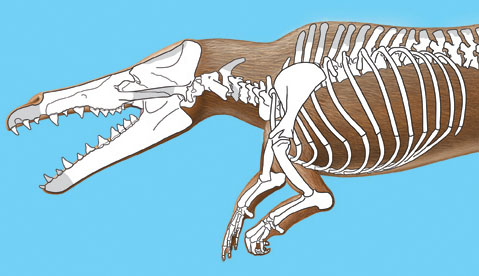Click on image for full size
Courtesy of John Klausmeyer and Bonnie Miljour, University of Michigan
Early Whales Gave Birth on Land
News story originally written on February 3, 2009
Scientists discovered two fossil whales in 2000 and 2004 in Pakistan. The fossils are a pregnant female and a male of the same species of primitive whale. After much work, scientists have made some exciting deductions!Even though the fossils are 47.5 million-years-old, scientists were able to tell that the female whale was pregnant. And the fetus was positioned for headfirst delivery, like land mammals but unlike modern whales, indicating that these whales still gave birth on land. The whale was named Maiacetus inuus. (Maiacetus means "mother whale," and Inuus was a Roman fertility god.)
Another clue to the whales' lifestyle is the well-developed set of teeth in the fetus, suggesting that Maiacetus newborns were equipped to fend for themselves, rather than being helpless in early life.
The 8.5-foot-long male specimen, collected four years later from the same fossil beds, shares physical features with the female, but its almost complete skeleton is 12 percent larger overall.
Both whales' big teeth, well-suited for catching and eating fish, suggest the animals made their living in the sea, probably coming onto land only to rest, mate and give birth, said paleontologist Gingerich. Gingerich led the team that made these exciting discoveries.
Like other primitive whales, Maiacetus had four legs modified for foot-powered swimming. They could support their weight on land, but not for a long distance. "They clearly were tied to the shore," Gingerich said. "They were living at the land-sea interface and going back and forth."
Scientists were definitely excited over this fossil find as Maiacetus shows us one of the important evolutionary steps that whales took as they made the transition from full-time land dwellers to ocean creatures.















